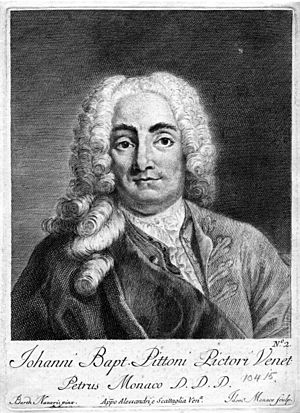Giambattista Pittoni facts for kids
Quick facts for kids
Giambattista Pittoni
|
|
|---|---|

Portrait of Pittoni by Bartolomeo Nazari
|
|
| Born | 6 June 1687 |
| Died | 6 November 1767 Venice
|
| Known for | painting |
| Style | late Baroque, Rococo |
Giambattista Pittoni (also known as Giovanni Battista Pittoni) was a famous Italian painter. He was born on June 6, 1687, and died on November 6, 1767. His paintings are known for their late Baroque and Rococo styles. Pittoni was one of the people who helped create the Academy of Fine Arts of Venice.
Pittoni was born in Venice, Italy. He spent most of his life working there. Around 1720, he traveled to France. This trip influenced his painting style. He started to use more French art ideas in his work. In 1716, Pittoni joined a group of painters in Venice. He was also the president of the Academy of Fine Arts of Venice twice. He led the Academy from 1758 to 1760, and again from 1763 to 1764. During his lifetime, many people across Italy wanted his paintings.
Contents
Famous Paintings by Pittoni
Giambattista Pittoni created many beautiful artworks. His paintings often showed stories from the Bible or ancient myths. He also painted scenes from history. Here are some of his well-known pieces:
The Miracle of the Loaves and Fishes
The Miracle of the Loaves and Fishes is a painting from 1725. It is now kept at the National Gallery of Victoria in Australia. This painting shows a story from the gospel of John in the Bible. In the story, Jesus feeds a large crowd of people. He uses only five loaves of bread and two fish. Pittoni's painting captures this amazing moment.
Other Important Works
- Bacchus and Ariadne of the Senate (1730s): This painting is in the Senate of the Republic (Italy) building in Rome. It shows characters from Greek mythology.
- Christ grants Keys of Paradise to St Peter: This painting is located in the Louvre Museum in Paris. It shows a religious scene.
- Continence of Scipio (1733–1735): Also at the Louvre, this work tells a story from Roman history.
- Susanna and the Elders (1723–1725): This painting, also in the Louvre, shows a story from the Bible.
- Holy Family: This religious painting can be seen at the Metropolitan Museum of Art in New York.
- The Annunciation: This oil painting is displayed at the Gallerie dell'Accademia in Venice. It shows the angel Gabriel telling Mary she will have a baby.
- Nativity (1740): This painting of the birth of Jesus is at the National Gallery in London.
- Sacrifice of Polyxena (1733–1734): This dramatic painting is part of the collection at the Getty Museum in Los Angeles.
- Death of Joseph: This painting is in the Berggruen Museum in Berlin. It shows a scene from the life of Saint Joseph.
Pittoni's Later Life and Legacy
Pittoni died in Venice on November 6, 1767. He was buried in the church of San Giacomo dell'Orio. After he died, people did not talk about his art as much. However, in the 1900s, interest in his paintings grew again. Today, he is recognized as an important artist of his time.
Images for kids
-
The Death of Sophonisba, in the Pushkin Museum in Moscow
-
View of the Brenta, near Dolo, in the Metropolitan Museum of Art in New York City.
See also
 In Spanish: Giovanni Battista Pittoni para niños
In Spanish: Giovanni Battista Pittoni para niños




